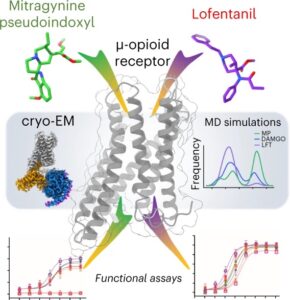
Image copyright – Cell.
Insights into distinct signaling profiles of the µOR activated by diverse agonists
Published in Nat Chem Biology (2022)
Authors
Xiaonan Fu, Li Sun, Runze Dong, Jane Y Chen, Runglawan Silakit, Logan F Condon, Yiing Lin, Shin Lin, Richard D Palmiter, Liangcai Gu
Paper presented by Dr. Agnieszka Sulima and selected by the NIDA TDI Paper of the Month Committee
Publication Brief Description
Analgesia, respiratory depression, and physiological dependence mediated by the mu opioid receptor (µOR) are thought to be dependent on G-protein pathways. However, the physiological roles of distinct G protein subtypes (Gi, Go and Gz) in opioid-induced antinociception and adverse effects are not well understood. Using a novel TRUPATH BREAT2 assay researchers at Stanford University evaluated efficacy profiles for all six G protein subtypes activation by lofentanil and mitragynine pseudoindoxyl, two µOR agonists with different potency and safety profiles. The results of the TRUPATH assay revealed that the two agonists engaged G proteins with markedly different efficacies and potency. The finding furthers our understanding of specific G protein subtypes in the therapeutic and adverse effects of µOR agonists. Furthermore, the TRUPATH BREAT2 assay, a single and comprehensive platform of 14 G protein biosensors, provides researchers an opportunity to examine functional selectivity of G protein subtypes in a ligand-specific manner using other GPCRs such as dopamine and serotonin receptors.
Insights into distinct signaling profiles of the µOR activated by diverse agonists Journal Article
In: Nat Chem Biol, vol. 19, no. 4, pp. 423–430, 2023, ISSN: 1552-4469.
